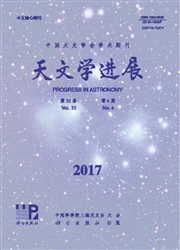

 中文摘要:
中文摘要:
贫金属星因其内在蕴涵着银河系早期化学元素形成和演化等信息,所以他们对银河系及宇宙早期形成历史的研究具有重要意义。目前对贫金属星的搜寻与研究已成为天文学的一大国际研究热点。随着郭守敬望远镜(LAMOST)试运行的开展及数据的积累,我国已具备自主开展此领域研究工作的有力观测设备及数据资源。通过采用有效的的测量方法,对郭守敬望远镜试观期获得的低分辨率(R≈2 000)恒星光谱数据进行恒星大气物理参数测量,新发现了8颗[Fe/H]〈-1.00 dex的贫金属星候选体,其中1颗[Fe/H]=-2.73dex属于很贫的贫金属星(VMP)。工作首次显示并证明了郭守敬望远镜能够有效地开展银河系内搜寻大量贫金属星的工作。
 英文摘要:
英文摘要:
Since metal-deficient stars preserve the chemical abundance formation and evolution information from the Galactic origin,they are regarded as fossils of the early generation of stars. Searching for them in large samples of stellar spectra is an important task related to stellar astrophysics. Guo Shou-jing Telescope(LAMOST),a 4-meter telescope with 4 000 fibers mounted on the large focal plane,has been already executing its commissioning observation and accumulating its observing dataset.The telescope can acquire 4 000 spectra in a 5 degree field at each exposure, and there might be a lot of metal-poor stars(here after MPs) hidden in the flood of data. To pick out MPs from LAMOST observations,the key process is to precisely measure the metallicity for each star.In the paper,three independent methods are applied to determine the metallicity of stars in an observation field of LAMOST,which were observed on Feb 13,2010.The resolution of the spectra is R~2 000.All targets are selected from UCAC3 with R magnitude brighter than 16.5 mag.The integration time of this field is 30 min for one exposure and 20 min for another.Seeing is about 3.3 arcsecond in that observation night. All raw data is reduced by standard LAMOST pipeline,including bias,flat,cosmic ray remove,sky subtraction,trace and extraction,and wavelength calibration etc.The observed spectrum of each target is assembled by two parts,blue range and red range,within 370-590 nm and 570-900 nm respectively.Lacking of flux standard stars in the observing plan,connection of the two parts of the individual spectrum is not smooth enough due to the approximate flux calibration.For the purpose on MPs searching,using the blue arm is enough,because most of the important abundance features are included in this wavelength range.Hence,in this work,we adopt this wavelength range for the metallicity measuring methods. Three stellar atmospheric parameters measuring methods mentioned above are ULySS,Non- Parametric Regression(NPR),and SSPP.ULySS is a newly developed
 同期刊论文项目
同期刊论文项目
 同项目期刊论文
同项目期刊论文
 A new synthetic library of the Near-Infrared CaII triplet indices. I.Index Definition, Calibration a
A new synthetic library of the Near-Infrared CaII triplet indices. I.Index Definition, Calibration a 期刊信息
期刊信息
